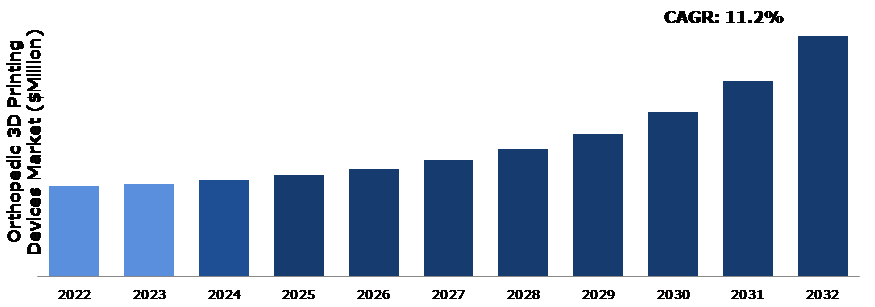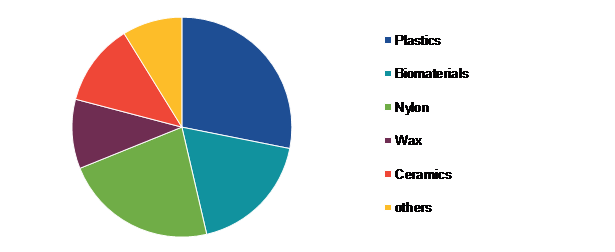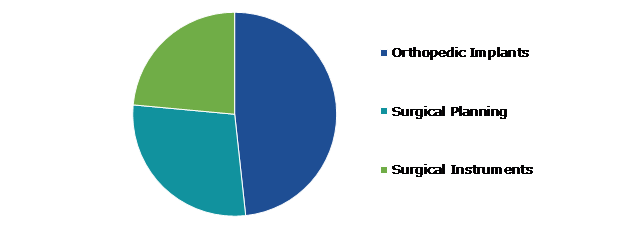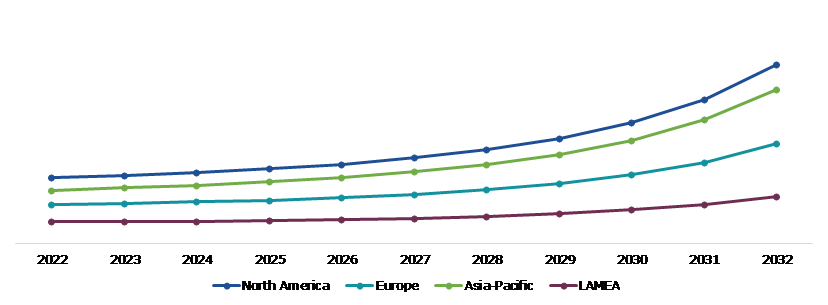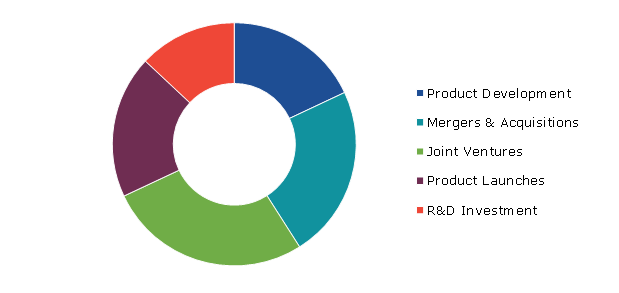Global Orthopedic 3D Printing Devices Market Report
RA08736
Global Orthopedic 3D Printing Devices Market by Type (Plastics, Biomaterials, Nylon, Wax, Ceramics, and Others), Application (Orthopedic Implants, Surgical Planning, and Surgical Instruments), and Region (North America, Europe, Asia-Pacific, and LAMEA): Opportunity Analysis and Industry Forecast, 2023-2032
Orthopedic 3D Printing Devices Overview
Orthopedic 3D printing devices refer to specialized medical devices used in the field of orthopedics that utilize 3D printing technology to create patient-specific implants, surgical guides, and other tools. Orthopedics is a branch of medicine that focuses on the prevention, diagnosis, and treatment of disorders and injuries of the musculoskeletal system, which includes bones, joints, ligaments, tendons, and muscles. Orthopedic 3D printing devices offer several advantages over traditional manufacturing methods in the field of orthopedics. They allow for the production of customized implants and surgical instruments that are customized to the unique anatomy of individual patients. By utilizing patient-specific data from medical imaging, such as CT scans or MRI, orthopedic surgeons can design and create implants that perfectly fit a patient's anatomy, leading to better surgical outcomes and improved patient comfort.
Orthopedic 3D printing devices have revolutionized the field of orthopedics by enabling personalized treatment options and improving surgical precision. The patient's affected area is scanned using techniques such as CT or MRI to generate a three-dimensional digital model of the anatomy. Orthopedic surgeons use specialized software to analyze the patient's anatomy and plan the design of the orthopedic device. This includes adjusting dimensions, angles, and other parameters to optimize the fit and functionality of the implant. The designed implant or surgical guide is fabricated using a 3D printer. The printer deposits layers of material, often biocompatible metals or polymers, based on the digital model. This additive manufacturing process allows for complex geometries and intricate internal structures.
Global Orthopedic 3D Printing Devices Market Analysis
The global orthopedic 3D printing devices market size was $1,965.60 million in 2022 and is predicted to grow with a CAGR of 11.2%, by generating a revenue of $5,266.40 million by 2032.
Source: Research Dive Analysis
COVID-19 Impact on Global Orthopedic 3D Printing Devices Market
The COVID-19 pandemic had significant impact on the orthopedic 3D printing devices market. The pandemic caused disruptions in the global supply chain such as the production and distribution of medical devices. This disruption affected the manufacturing and transport of orthopedic 3D printing devices also leading to delays and shortages in some cases. There was a surge in the demand for personal protective equipment (PPE), along with masks, face shields, and different equipment during the outbreak of COVID-19. Some 3D printing companies shifted their focus to producing PPE using their additive manufacturing capabilities, diverting resources from orthopedic 3D printing devices.
Many hospitals and healthcare facilities postponed elective surgeries during the peak of the pandemic to prioritize COVID-19 patients. This delay in non-essential surgeries, which includes orthopedic procedures, had a negative impact on the demand for orthopedic implants and devices. 3D printing technology allows for the creation of patient-specific implants and prosthetics, designed to individual needs. This customization capability had gained importance during the pandemic as healthcare providers aimed to minimize patient contact and optimize surgical outcomes.
Rising Demand for Personalized and Customized Solutions to Drive the Market Growth
Orthopedic 3D printing allows for the production of customized and personalized options tailored to individual patients. This technology enables orthopedic implants, prosthetics, and surgical guides to be designed and manufactured according to a patient's particular anatomical requirements, resulting in improved patient outcomes. Moreover, orthopedic 3D printing enables the production of patient-specific implants that are personalized to fit a patient's unique anatomy. Traditional implants are regularly limited to standard sizes and shapes, which may not provide an ideal fit for each patient. With 3D printing, implants can be designed based on patient-specific imaging data, resulting in better fit, increased functionality, and reduced complications. In addition, 3D printing technology allows for the creation of highly customized prosthetic devices. Each patient's residual limb can be scanned and used to design prosthetics that precisely match their anatomy and provide optimal comfort and functionality. Customized prosthetics can significantly enhance mobility and quality of life for individuals with limb loss. Orthopedic 3D printing enables the production of surgical guides that assist surgeons during complex procedures. These guides are created based on a patient's specific anatomy, providing accurate guidance and improving surgical precision. By using personalized surgical guides, surgeons can reduce operative time, minimize errors, and enhance patient safety. The ability of orthopedic 3D printing to provide personalized and customized solutions based on individual patient requirements is a significant driver for its adoption in the market.
To know more about global orthopedic 3D printing devices market drivers, get in touch with our analysts here.
High Initial Cost of Orthopedic 3D Printing Devices to Restrain the Market Growth
The cost-related factors can pose challenges, particularly for smaller healthcare facilities or regions with limited resources. Orthopedic 3D printing devices are complex and specialized machines that require advanced technology and materials. The initial purchase cost of these devices can be high, making it a substantial investment for healthcare facilities, particularly smaller ones with limited budgets. Setting up the infrastructure for orthopedic 3D printing involves creating a dedicated space with proper ventilation, power supply, and safety measures. This may require renovations or the construction of a specialized facility which adds to the overall cost. The materials used in orthopedic 3D printing such as metal alloys or biocompatible polymers, can be expensive. In addition, the cost of obtaining regulatory approvals for these materials further adds to the overall expense. In some healthcare systems or regions, there may be limited or no reimbursement for orthopedic 3D printing procedures. This lack of financial support can make it difficult for healthcare facilities to justify the upfront investment and ongoing costs associated with these devices, which is anticipated to hamper the orthopedic 3D printing devices market growth.
Increasing Development of Healthcare Infrastructure to Create Excellent Opportunities
Advanced healthcare infrastructure fosters the adoption of innovative technologies, including virtual surgical planning and simulation. Orthopedic 3D printing devices can be integrated with these systems to create accurate anatomical models for preoperative planning and surgical training. Surgeons can visualize complex cases, practice surgical techniques, and identify potential challenges beforehand, leading to improved surgical outcomes and reduced complications. Moreover, 3D printing has the potential to improve accessibility to prosthetic devices, particularly in regions with limited healthcare resources. With the development of healthcare infrastructure, more clinics and hospitals can integrate 3D printing technology into their facilities, allowing them to produce cost-effective and customized prosthetic devices. This technology enables faster production, reduced costs, and improved functionality, leading to better access to prosthetics for patients in need. The growth of healthcare infrastructure often coincides with increased investments in R&D. Orthopedic 3D printing devices offer opportunities for innovation and advancement in the field. Researchers can explore new materials, printing techniques, and implant designs to further enhance the capabilities and outcomes of 3D-printed orthopedic devices. With the support of a robust healthcare infrastructure, such research initiatives can flourish and lead to developments in the field. These opportunities can drive the adoption and advancement of orthopedic 3D printing technology, ultimately benefiting patients and healthcare providers.
To know more about global orthopedic 3D printing devices market opportunities, get in touch with our analysts here.
Global Orthopedic 3D Printing Devices Share, by Type, 2022
Source: Research Dive Analysis
The plastics sub-segment accounted for the highest orthopedic 3D printing devices market share in 2022. Plastics are utilized in the worldwide orthopedic market to manufacture devices such as knee joints and bones. Plastics are important in the medical device sector because of their unique qualities such as biocompatibility, low cost, and ease of availability. Therefore, they have developed as a significant material that is widely used in a variety of applications, including surgical implants and equipment. In addition, plastic 3D printing can create lightweight orthopedic instruments without compromising strength or durability. This is especially beneficial for devices such as prostheses, which can improve patient comfort and mobility by minimizing weight. All these factors are anticipated boost the plastics segment growth in the orthopedic 3D printing devices market.
Source: Research Dive Analysis
The orthopedic implants sub-segment accounted for the highest market share in 2022. Surgical implants have been the preferred option for patients requiring prosthesis replacement surgery or bone repair procedures. The rising prevalence of musculoskeletal problems due to sedentary lifestyles, along with an aging population, is likely to boost growth of this market during the forecast period. Therefore, orthopedic implants are expected to be one of the fastest expanding areas in both developed and developing countries over the next few years.
Global Orthopedic 3D Printing Devices Market Size & Forecast, by Region, 2022-2032 ($Million)
Source: Research Dive Analysis
The North America orthopedic 3D printing devices market share generated the highest revenue in 2022. The North America orthopedic 3D printing devices market has experienced significant growth over the past few years due to technological advancements. Advancements in 3D printing technology, such as faster print speeds, higher resolutions, and the discovery of new materials, have contributed to the expansion of the orthopedic 3D printing devices market demand. These developments have enabled the production of more sophisticated and precise orthopedic devices, increasing the use of 3D printing in this field. Regulatory agencies such as the U.S. Food and Drug Administration (FDA) have recognized the potential of 3D printing in medicine and have issued recommendations to support its adoption. The FDA has developed a regulatory process for approving 3D printed medical devices, driving innovation and growth in the orthopedic 3D printing devices business.
Competitive Scenario in the Global Orthopedic 3D Printing Devices Market
Investment and agreement are common strategies followed by major market players. For instance, SLM Solutions partnered with Canwell Medical in 2020. The partnership will allow Canwell Medical to use SLM machines to manufacture 3D printed surgical implant products.
Source: Research Dive Analysis
Some of the leading orthopedic 3D printing devices market analysis players are Stryker, 3D Systems Corp, ENVISIONTEC US LLC, EOS GmbH Electro Optical Systems, General Electric, Smith & Nephew, Johnson & Johnson, Abbott, Zimmer Biomet Holding Inc., and Aspect Biosystems Ltd.
| Aspect | Particulars |
| Historical Market Estimations | 2020-2021 |
| Base Year for Market Estimation | 2022 |
| Forecast Timeline for Market Projection | 2023-2032 |
| Geographical Scope | North America, Europe, Asia-Pacific, and LAMEA |
| Segmentation by Type |
|
| Segmentation by Application |
|
| Key Companies Profiled |
|
Q1. What is the size of the global orthopedic 3D printing devices market?
A. The size of the global orthopedic 3D printing devices market was over $1,965.60 million in 2022 and is projected to reach $5,266.40 million by 2032.
Q2. Which are the major companies in the orthopedic 3D printing devices market?
A. Stryker, 3D Systems Corp, and ENVISIONTEC US LLC are some of the key players in the global orthopedic 3D printing devices market.
Q3. Which region, among others, possesses greater investment opportunities in the future?
A. Asia-Pacific possesses great investment opportunities for investors in the future.
Q4. What will be the growth rate of the Asia-Pacific orthopedic 3D printing devices market?
A. Asia-Pacific orthopedic 3D printing devices market is anticipated to grow at 12.0% CAGR during the forecast period.
Q5. What are the strategies opted by the leading players in this market?
A. Agreement and investment are the two key strategies opted by the operating companies in this market.
Q6. Which companies are investing more on R&D practices?
A. Smith & Nephew, Johnson & Johnson, Abbott, Zimmer Biomet Holding Inc., and Aspect Biosystems Ltd. are the companies investing more on R&D activities for developing new products and technologies.
1.Research Methodology
1.1.Desk Research
1.2.Real time insights and validation
1.3.Forecast model
1.4.Assumptions and forecast parameters
1.5.Market size estimation
1.5.1.Top-down approach
1.5.2.Bottom-up approach
2.Report Scope
2.1.Market definition
2.2.Key objectives of the study
2.3.Report overview
2.4.Market segmentation
2.5.Overview of the impact of COVID-19 on Global orthopedic 3D printing devices market
3.Executive Summary
4.Market Overview
4.1.Introduction
4.2.Growth impact forces
4.2.1.Drivers
4.2.2.Restraints
4.2.3.Opportunities
4.3.Market value chain analysis
4.3.1.List of raw material suppliers
4.3.2.List of manufacturers
4.3.3.List of distributors
4.4.Innovation & sustainability matrices
4.4.1.Technology matrix
4.4.2.Regulatory matrix
4.5.Porter’s five forces analysis
4.5.1.Bargaining power of suppliers
4.5.2.Bargaining power of consumers
4.5.3.Threat of substitutes
4.5.4.Threat of new entrants
4.5.5.Competitive rivalry intensity
4.6.PESTLE analysis
4.6.1.Political
4.6.2.Economical
4.6.3.Social
4.6.4.Technological
4.6.5.Environmental
4.7.Impact of COVID-19 on orthopedic 3D printing devices market
4.7.1.Pre-covid market scenario
4.7.2.Post-covid market scenario
5.Orthopedic 3D Printing Devices Market Analysis, by Type
5.1.Overview
5.2.Plastics
5.2.1.Definition, key trends, growth factors, and opportunities
5.2.2.Market size analysis, by region, 2022-2032
5.2.3.Market share analysis, by country, 2022-2032
5.3.Biomaterials
5.3.1.Definition, key trends, growth factors, and opportunities
5.3.2.Market size analysis, by region, 2022-2032
5.3.3.Market share analysis, by country, 2022-2032
5.4.Nylon
5.4.1.Definition, key trends, growth factors, and opportunities
5.4.2.Market size analysis, by region, 2022-2032
5.4.3.Market share analysis, by country, 2022-2032
5.5. Wax
5.5.1.Definition, key trends, growth factors, and opportunities
5.5.2.Market size analysis, by region, 2022-2032
5.5.3.Market share analysis, by country, 2022-2032
5.6.Ceramics
5.6.1.Definition, key trends, growth factors, and opportunities
5.6.2.Market size analysis, by region, 2022-2032
5.6.3.Market share analysis, by country, 2022-2032
5.7.Others
5.7.1.Definition, key trends, growth factors, and opportunities
5.7.2.Market size analysis, by region, 2022-2032
5.7.3.Market share analysis, by country, 2022-2032
5.8.Research Dive Exclusive Insights
5.8.1.Market attractiveness
5.8.2.Competition heatmap
6.Orthopedic 3D Printing Devices Market Analysis, by Application
6.1.Orthopedic Implants
6.1.1.Definition, key trends, growth factors, and opportunities
6.1.2.Market size analysis, by region, 2022-2032
6.1.3.Market share analysis, by country, 2022-2032
6.2.Surgical Planning
6.2.1.Definition, key trends, growth factors, and opportunities
6.2.2.Market size analysis, by region, 2022-2032
6.2.3.Market share analysis, by country, 2022-2032
6.3.Surgical Instruments
6.3.1.Definition, key trends, growth factors, and opportunities
6.3.2.Market size analysis, by region, 2022-2032
6.3.3.Market share analysis, by country, 2022-2032
6.4.Research Dive Exclusive Insights
6.4.1.Market attractiveness
6.4.2.Competition heatmap
7.Orthopedic 3D Printing Devices Market, by Region
7.1.North America
7.1.1.U.S.
7.1.1.1.Market size analysis, by Type, 2022-2032
7.1.1.2.Market size analysis, by Application, 2022-2032
7.1.2.Canada
7.1.2.1.Market size analysis, by Type, 2022-2032
7.1.2.2.Market size analysis, by Application, 2022-2032
7.1.3.Mexico
7.1.3.1.Market size analysis, by Type, 2022-2032
7.1.3.2.Market size analysis, by Application, 2022-2032
7.1.4.Research Dive Exclusive Insights
7.1.4.1.Market attractiveness
7.1.4.2.Competition heatmap
7.2.Europe
7.2.1.Germany
7.2.1.1.Market size analysis, by Type, 2022-2032
7.2.1.2.Market size analysis, by Application, 2022-2032
7.2.2.UK
7.2.2.1.Market size analysis, by Type, 2022-2032
7.2.2.2.Market size analysis, by Application, 2022-2032
7.2.3.France
7.2.3.1.Market size analysis, by Type, 2022-2032
7.2.3.2.Market size analysis, by Application, 2022-2032
7.2.4.Spain
7.2.4.1.Market size analysis, by Type, 2022-2032
7.2.4.2.Market size analysis, by Application, 2022-2032
7.2.5.Italy
7.2.5.1.Market size analysis, by Type, 2022-2032
7.2.5.2.Market size analysis, by Application, 2022-2032
7.2.6.Rest of Europe
7.2.6.1.Market size analysis, by Type, 2022-2032
7.2.6.2.Market size analysis, by Application, 2022-2032
7.2.7.Research Dive Exclusive Insights
7.2.7.1.Market attractiveness
7.2.7.2.Competition heatmap
7.3.Asia-Pacific
7.3.1.China
7.3.1.1.Market size analysis, by Type, 2022-2032
7.3.1.2.Market size analysis, by Application, 2022-2032
7.3.2.Japan
7.3.2.1.Market size analysis, by Type, 2022-2032
7.3.2.2.Market size analysis, by Application, 2022-2032
7.3.3.India
7.3.3.1.Market size analysis, by Type, 2022-2032
7.3.3.2.Market size analysis, by Application, 2022-2032
7.3.4.Australia
7.3.4.1.Market size analysis, by Type, 2022-2032
7.3.4.2.Market size analysis, by Application, 2022-2032
7.3.5.South Korea
7.3.5.1.Market size analysis, by Type, 2022-2032
7.3.5.2.Market size analysis, by Application, 2022-2032
7.3.6.Rest of Asia-Pacific
7.3.6.1.Market size analysis, by Type, 2022-2032
7.3.6.2.Market size analysis, by Application, 2022-2032
7.3.7.Research Dive Exclusive Insights
7.3.7.1.Market attractiveness
7.3.7.2.Competition heatmap
7.4.LAMEA
7.4.1.Brazil
7.4.1.1.Market size analysis, by Type, 2022-2032
7.4.1.2.Market size analysis, by Application, 2022-2032
7.4.2.Saudi Arabia
7.4.2.1.Market size analysis, by Type, 2022-2032
7.4.2.2.Market size analysis, by Application, 2022-2032
7.4.3.UAE
7.4.3.1.Market size analysis, by Type, 2022-2032
7.4.3.2.Market size analysis, by Application, 2022-2032
7.4.4.South Africa
7.4.4.1.Market size analysis, by Type, 2022-2032
7.4.4.2.Market size analysis, by Application, 2022-2032
7.4.5.Rest of LAMEA
7.4.5.1.Market size analysis, by Type, 2022-2032
7.4.5.2.Market size analysis, by Application, 2022-2032
7.4.6.Research Dive Exclusive Insights
7.4.6.1.Market attractiveness
7.4.6.2.Competition heatmap
8.Competitive Landscape
8.1.Top winning strategies, 2022
8.1.1.By strategy
8.1.2.By year
8.2.Strategic overview
8.3.Market share analysis, 2022
9.Company Profiles
9.1.Stryker
9.1.1.Overview
9.1.2.Business segments
9.1.3.Product portfolio
9.1.4.Financial performance
9.1.5.Recent developments
9.1.6.SWOT analysis
9.2.3D Systems Corp
9.2.1.Overview
9.2.2.Business segments
9.2.3.Product portfolio
9.2.4.Financial performance
9.2.5.Recent developments
9.2.6.SWOT analysis
9.3.ENVISIONTEC US LLC
9.3.1.Overview
9.3.2.Business segments
9.3.3.Product portfolio
9.3.4.Financial performance
9.3.5.Recent developments
9.3.6.SWOT analysis
9.4.EOS GmbH Electro Optical Systems
9.4.1.Overview
9.4.2.Business segments
9.4.3.Product portfolio
9.4.4.Financial performance
9.4.5.Recent developments
9.4.6.SWOT analysis
9.5.General Electric
9.5.1.Overview
9.5.2.Business segments
9.5.3.Product portfolio
9.5.4.Financial performance
9.5.5.Recent developments
9.5.6.SWOT analysis
9.6.Smith & Nephew
9.6.1.Overview
9.6.2.Business segments
9.6.3.Product portfolio
9.6.4.Financial performance
9.6.5.Recent developments
9.6.6.SWOT analysis
9.7.Johnson & Johnson
9.7.1.Overview
9.7.2.Business segments
9.7.3.Product portfolio
9.7.4.Financial performance
9.7.5.Recent developments
9.7.6.SWOT analysis
9.8.Abbott
9.8.1.Overview
9.8.2.Business segments
9.8.3.Product portfolio
9.8.4.Financial performance
9.8.5.Recent developments
9.8.6.SWOT analysis
9.9.Zimmer Biomet Holding Inc.
9.9.1.Overview
9.9.2.Business segments
9.9.3.Product portfolio
9.9.4.Financial performance
9.9.5.Recent developments
9.9.6.SWOT analysis
9.10.Aspect Biosystems Ltd.
9.10.1.Overview
9.10.2.Business segments
9.10.3.Product portfolio
9.10.4.Financial performance
9.10.5.Recent developments
9.10.6.SWOT analysis
Personalize this research
- Triangulate with your own data
- Request your format and definition
- Get a deeper dive on a specific application, geography, customer or competitor
- + 1-888-961-4454 Toll - Free
- support@researchdive.com

